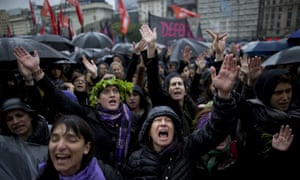With the presidential victory already in hand, we’ve seen Trump begin to “backtrack” on several policy stances he strongly spoke to during his campaign. For example, during his 60 minutes interview he stated the desire to keep several concepts of Obamacare such as providing coverage for people with preexisting conditions and children still living with their parents. Additionally, he has declared to not pursue criminal charges against Hillary Clinton once in Office, an advisor from his camp said Trump may not “rip up” the Iran deal but will review it, and in a recent New York Times interview stated “I think there is some connectivity” between climate change and human production. One cannot help but wonder if Trump’s stances during his election were simply strategic to attract a certain voter base; however, The Atlantic published an article that warns against jumping to that conclusion.
“Talk like a Moderate. Act like an Extremist.”
Although Trump is making public statements that may put the minds of moderates and liberals more at ease, it is essential for one to look to his appointments and actions. Whether one agrees with Trump or not, he seems to have a tendency to say what people need/want to hear the most. Could his more moderate policy changes be a simple tactic of calming down his opposition, all the while he appoints individuals who will pursue the extremist stances he championed for during the campaign? This is what the Atlantic article argues. Although Trump has appeared to shift more center, his team of appointments includes Myron Ebell to the EPA, a long-time climate change skeptic who expressed plans to cut NASA’s “politically correct” Earth Science research, and Steven Groves to the State Department who is advocating for withdrawal from the Paris Climate Deal and a “dismantling” of domestic climate regulations. It is far more important to look to Trump’s transition team than it is to cling to his post-victory claims. With a divided nation, it makes sense for Trump to moderate some of his stances, but this does not necessarily translate into less extremist action.




